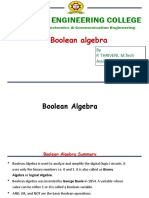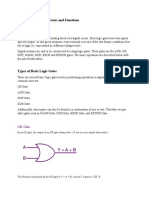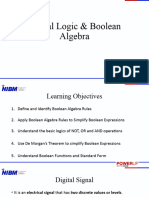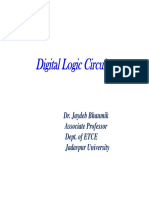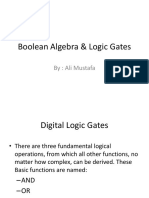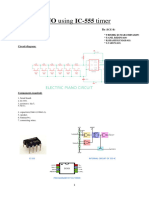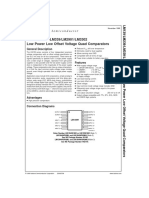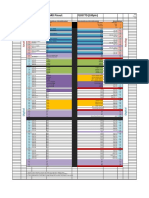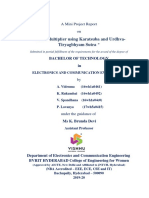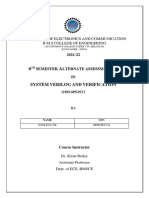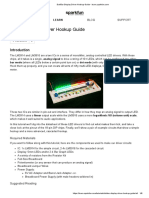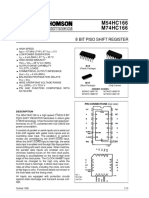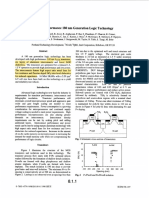Boolean Algebra
Boolean Algebra is used to analyze and simplify the digital (logic) circuits. It uses only
the binary numbers i.e. 0 and 1. It is also called as Binary Algebra or logical
Algebra. Boolean algebra was invented by George Boole in 1854.
Rule in Boolean Algebra
Following are the important rules used in Boolean algebra.
Variable used can have only two values. Binary 1 for HIGH and Binary 0 for LOW.
Complement of a variable is represented by an over bar (-). Thus, complement of
variable B is represented as . Thus if B = 0 then = 1 and B = 1 then = 0.
ORing of the variables is represented by a plus (+) sign between them. For
example ORing of A, B, C is represented as A + B + C.
Logical ANDing of the two or more variable is represented by writing a dot
between them such as A.B.C. Sometime the dot may be omitted like ABC.
Boolean Laws
There are six types of Boolean Laws.
Commutative law
Any binary operation which satisfies the following expression is referred to as commutative
operation.
Page 28
�Commutative law states that changing the sequence of the variables does not have any effect on the
output of a logic circuit.
Associative law
This law states that the order in which the logic operations are performed is irrelevant as
their effect is the same.
Distributive law
Distributive law states the following condition.
AND law
These laws use the AND operation. There fore they are called as AND laws.
OR law
These laws use the OR operation. There fore they are called as OR laws.
INVERSION law
This law uses the NOT operation. The inversion law states that double inversion of a variable
results in the original variable itself.
Page 29
�LOGIC GATES
Logic gates are the basic building blocks of any digital system. It is an electronic circuit
having one or more than one input and only one output. The relationship between the
input and the output is based on a certain logic. Based on this, logic gates are named
as AND gate, OR gate, NOT gate etc.
AND Gate
A circuit which performs an AND operation is shown in figure. It has n input (n >= 2) and one
output.
Logic diagram
Truth Table
Page 30
� OR Gate
A circuit which performs an OR operation is shown in figure. It has n input (n >= 2) and one
output.
Logic diagram
Truth Table
NOT Gate
NOT gate is also known as Inverter. It has one input A and one output Y.
Logic diagram
Page 31
� Truth Table
NAND Gate
A NOT-AND operation is known as NAND operation. It has n input (n >= 2) and one output.
Logic diagram
Truth Table
Page 32
� NOR Gate
A NOT-OR operation is known as NOR operation. It has n input (n >= 2) and one output.
Logic diagram
Truth Table
XOR Gate
XOR or Ex-OR gate is a special type of gate. It can be used in the half adder, full adder
and subtractor. The exclusive-OR gate is abbreviated as EX-OR gate or sometime as X-
OR gate. It has ninput (n >= 2) and one output.
Logic diagram
Page 33
� Truth Table
XNOR Gate
XNOR gate is a special type of gate. It can be used in the half adder, full adder and
subtractor. The exclusive-NOR gate is abbreviated as EX-NOR gate or sometime as X-
NOR gate. It has n input (n >=2) and one output.
Logic diagram
Truth Table
Page 34
��Department of ECE Digital Logic Design
Theorems of Boolean Algebra
The following two theorems are used in Boolean algebra.
Duality theorem
DeMorgan’s theorem
Duality Theorem
This theorem states that the dual of the Boolean function is obtained by interchanging the logical AND
operator with logical OR operator and zeros with ones. For every Boolean function, there will be a
corresponding Dual function.
Let us make the Boolean equations (relations) that we discussed in the section of Boolean postulates
and basic laws into two groups. The following table shows these two groups.
Group1 Group2
x+0=x x.1 = x
x+1=1 x.0 = 0
x+x=x x.x = x
x + x’ = 1 x.x’ = 0
x+y=y+x x.y = y.x
x + (y + z) = (x + y) + z x.(y.z) = (x.y).z
x.(y + z) = x.y + x.z x + (y.z) = (x + y).(x + z)
In each row, there are two Boolean equations and they are dual to each other. We can verify all these
Boolean equations of Group1 and Group2 by using duality theorem.
















